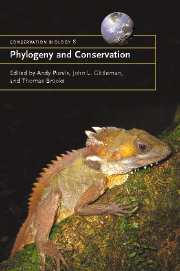Book contents
- Frontmatter
- Contents
- List of contributors
- 1 Phylogeny and conservation
- Part 1 Units and currencies
- 2 Molecular phylogenetics for conservation biology
- 3 Species: demarcation and diversity
- 4 Phylogenetic units and currencies above and below the species level
- 5 Integrating phylogenetic diversity in the selection of priority areas for conservation: does it make a difference?
- 6 Evolutionary heritage as a metric for conservation
- Part 2 Inferring evolutionary processes
- Part 3 Effects of human processes
- Part 4 Prognosis
- Index
- References
4 - Phylogenetic units and currencies above and below the species level
Published online by Cambridge University Press: 04 December 2009
- Frontmatter
- Contents
- List of contributors
- 1 Phylogeny and conservation
- Part 1 Units and currencies
- 2 Molecular phylogenetics for conservation biology
- 3 Species: demarcation and diversity
- 4 Phylogenetic units and currencies above and below the species level
- 5 Integrating phylogenetic diversity in the selection of priority areas for conservation: does it make a difference?
- 6 Evolutionary heritage as a metric for conservation
- Part 2 Inferring evolutionary processes
- Part 3 Effects of human processes
- Part 4 Prognosis
- Index
- References
Summary
INTRODUCTION
Biology has few universal laws, but one unassailable truth is that every organism alive today had one or two parents who in turn had parents and so on in an unbroken stream of heredity tracing back to the origins of life on Earth. Most lineages (asexual or sexual) became extinct along the way, but every pedigree that managed to survive to the present has maintained a continuous flow of genetic transmission, generation after generation, across nearly four billion years.
The fundamental challenge for phylogenetic biology is to chart these genetic streams: to estimate their lengths and plumb their depths, to discover their connections through shared ancestors, and in general to explore their evolutionary courses (Simpson 1945). Ever since Charles Darwin (1859) and Ernst Haeckel (1866), the usual metaphor for these extended hereditary channels has been not a river system or watershed, but rather a phylogenetic tree. The full tree of life describes biodiversity; in a sense, it is biodiversity, past and present. At any horizon in time, the standing crop of biodiversity can be interpreted as the legacy of phylogeny, defined broadly here to encompass notions of genetic relationships at temporal scales ranging from recent kinship ties within and among conspecific populations to distant evolutionary connections between higher taxa.
The fundamental challenge for conservation biology is to promote the continuance of the outermost tips in the tree of life: to protect the vigorous as well as the most tender of the extant shoots so that, in this latest instant of geological time, humanity does not terminate what nature has propagated across the aeons.
- Type
- Chapter
- Information
- Phylogeny and Conservation , pp. 76 - 100Publisher: Cambridge University PressPrint publication year: 2005
References
- 22
- Cited by



